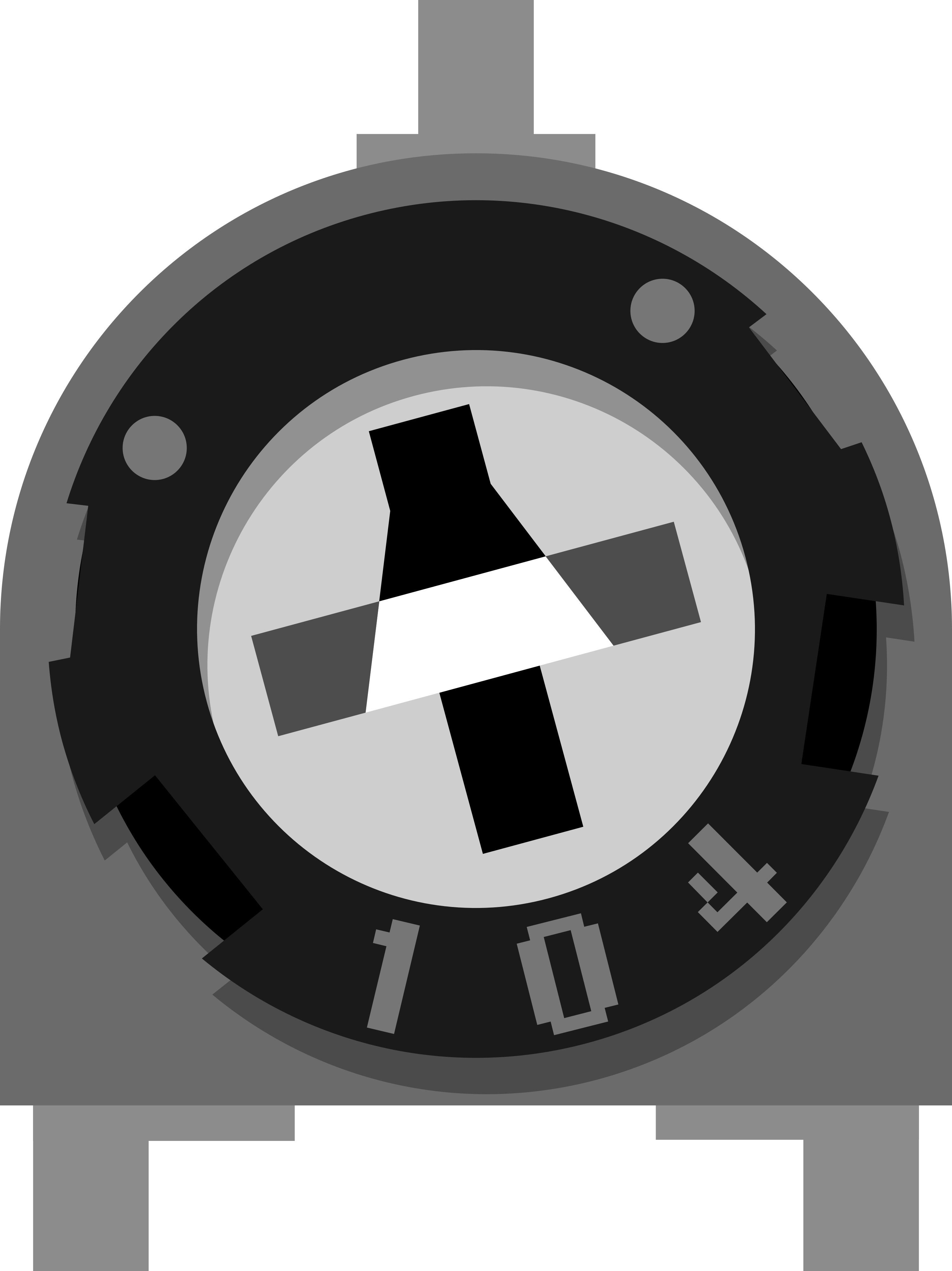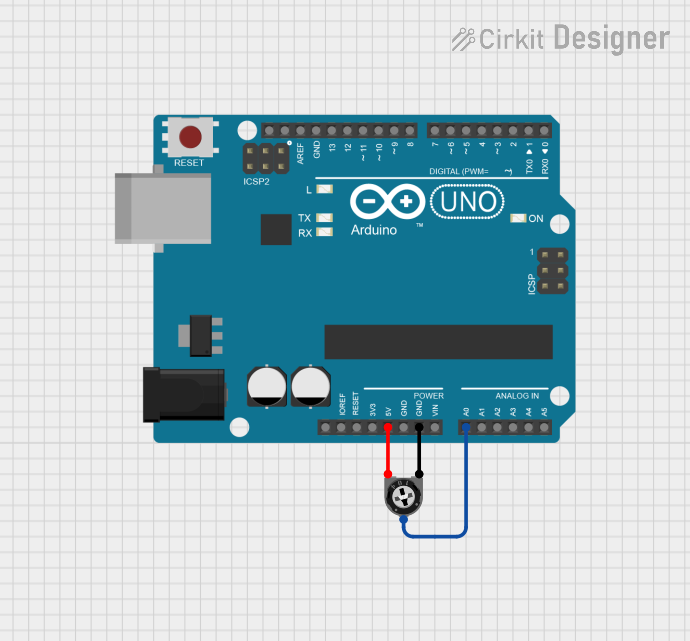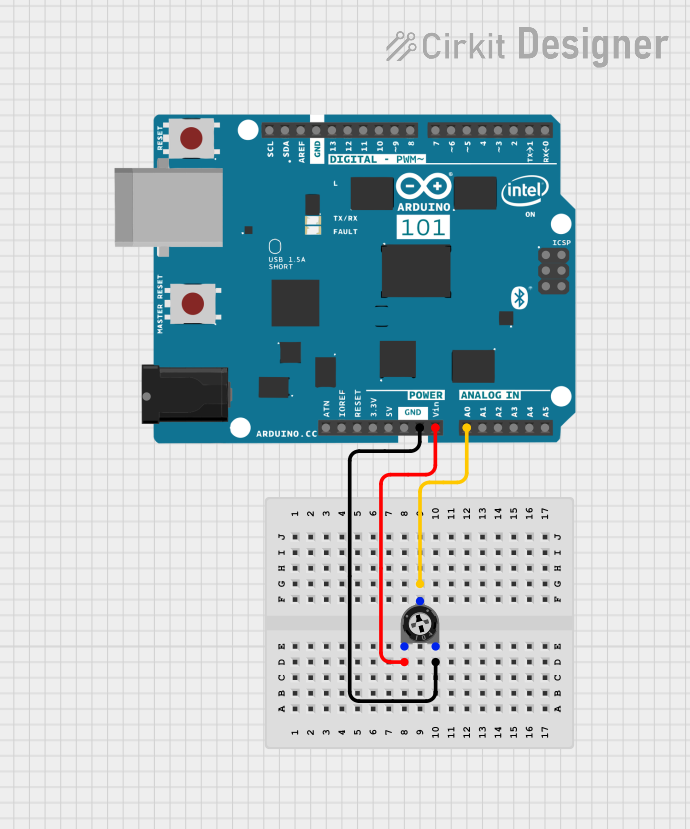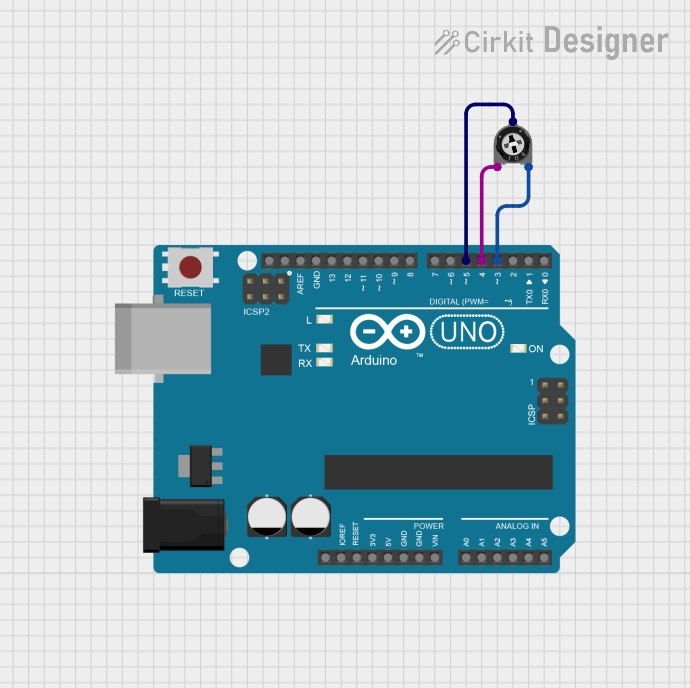
How to Use Trimmer Potentiometer: Examples, Pinouts, and Specs

 Design with Trimmer Potentiometer in Cirkit Designer
Design with Trimmer Potentiometer in Cirkit DesignerIntroduction
The Trimmer Potentiometer (Manufacturer: jjy, Part ID: trimmer) is a small, adjustable resistor designed for fine-tuning and calibration in electronic circuits. It allows users to precisely adjust resistance values to meet specific requirements. Trimmer potentiometers are commonly used in applications such as setting reference voltages, adjusting signal levels, and calibrating sensors.
Explore Projects Built with Trimmer Potentiometer

 Open Project in Cirkit Designer
Open Project in Cirkit Designer
 Open Project in Cirkit Designer
Open Project in Cirkit Designer
 Open Project in Cirkit Designer
Open Project in Cirkit Designer
 Open Project in Cirkit Designer
Open Project in Cirkit DesignerExplore Projects Built with Trimmer Potentiometer

 Open Project in Cirkit Designer
Open Project in Cirkit Designer
 Open Project in Cirkit Designer
Open Project in Cirkit Designer
 Open Project in Cirkit Designer
Open Project in Cirkit Designer
 Open Project in Cirkit Designer
Open Project in Cirkit DesignerCommon Applications and Use Cases
- Calibration of analog circuits
- Adjusting gain in amplifiers
- Setting reference voltages in voltage dividers
- Fine-tuning sensor outputs
- Balancing bridge circuits
Technical Specifications
Below are the key technical details for the jjy trimmer potentiometer:
| Parameter | Value |
|---|---|
| Resistance Range | 100 Ω to 1 MΩ (varies by model) |
| Tolerance | ±10% |
| Power Rating | 0.25 W (at 70°C) |
| Maximum Voltage | 50 V |
| Adjustment Type | Single-turn or multi-turn |
| Operating Temperature | -55°C to +125°C |
| Mounting Type | Through-hole or surface-mount |
Pin Configuration and Descriptions
The trimmer potentiometer typically has three pins:
| Pin | Description |
|---|---|
| Pin 1 | One end of the resistive track (fixed resistance point) |
| Pin 2 | Wiper (adjustable resistance point, varies based on the position of the wiper) |
| Pin 3 | The other end of the resistive track (fixed resistance point) |
Note: The wiper (Pin 2) provides the adjustable resistance between Pin 1 and Pin 3.
Usage Instructions
How to Use the Component in a Circuit
- Identify the Pins: Locate the three pins of the trimmer potentiometer. Use a multimeter to confirm the pinout if necessary.
- Connect the Pins:
- Connect Pin 1 and Pin 3 to the circuit where a fixed resistance is required.
- Connect Pin 2 (wiper) to the point where the adjustable resistance is needed.
- Adjust the Resistance:
- Use a small screwdriver to turn the adjustment screw on the trimmer.
- Turning clockwise typically decreases the resistance between Pin 2 and Pin 1, while increasing the resistance between Pin 2 and Pin 3 (and vice versa).
- Test the Circuit: Measure the resistance or output voltage to ensure the desired adjustment has been achieved.
Important Considerations and Best Practices
- Power Rating: Ensure the trimmer does not exceed its power rating (0.25 W at 70°C). Exceeding this limit may damage the component.
- Mechanical Stress: Avoid applying excessive force when adjusting the screw to prevent damage to the wiper mechanism.
- Stability: For applications requiring high stability, use multi-turn trimmers for finer adjustments.
- Mounting: Ensure proper soldering for through-hole or surface-mount types to maintain a reliable connection.
Example: Using a Trimmer Potentiometer with Arduino UNO
The trimmer potentiometer can be used as a variable voltage divider to provide an analog input to an Arduino UNO. Below is an example circuit and code:
Circuit Connections
- Connect Pin 1 to 5V on the Arduino.
- Connect Pin 3 to GND on the Arduino.
- Connect Pin 2 (wiper) to A0 (analog input pin) on the Arduino.
Arduino Code
// Example code to read the trimmer potentiometer value using Arduino UNO
const int potPin = A0; // Pin A0 is connected to the wiper of the trimmer
int potValue = 0; // Variable to store the potentiometer value
void setup() {
Serial.begin(9600); // Initialize serial communication at 9600 baud
}
void loop() {
potValue = analogRead(potPin); // Read the analog value from the trimmer
Serial.print("Potentiometer Value: ");
Serial.println(potValue); // Print the value to the Serial Monitor
delay(500); // Wait for 500ms before the next reading
}
Note: The analog value will range from 0 to 1023, corresponding to 0V to 5V.
Troubleshooting and FAQs
Common Issues and Solutions
No Change in Resistance:
- Cause: The wiper (Pin 2) is not properly connected.
- Solution: Verify the connections and ensure the wiper is correctly wired to the circuit.
Trimmer Not Adjusting Smoothly:
- Cause: Dust or debris inside the trimmer mechanism.
- Solution: Clean the trimmer with compressed air or replace it if damaged.
Component Overheating:
- Cause: Exceeding the power rating or voltage limit.
- Solution: Check the circuit design and ensure the trimmer operates within its specified limits.
Inconsistent Readings:
- Cause: Poor soldering or loose connections.
- Solution: Inspect and re-solder the connections as needed.
FAQs
Q1: Can I use a trimmer potentiometer for high-current applications?
A1: No, trimmer potentiometers are designed for low-power applications. For high-current circuits, use a power resistor or a different type of variable resistor.
Q2: How do I choose the right resistance value for my application?
A2: Determine the required resistance range for your circuit and select a trimmer potentiometer with a maximum resistance value slightly higher than your needs.
Q3: What is the difference between single-turn and multi-turn trimmers?
A3: Single-turn trimmers allow quick adjustments but are less precise. Multi-turn trimmers provide finer control and are ideal for applications requiring high precision.
Q4: Can I replace a trimmer potentiometer with a fixed resistor?
A4: Yes, but only if the required resistance value is known and does not need adjustment.